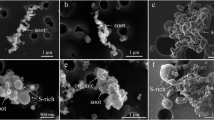Abstract
The light-scattering properties of mineral dust and soot particles in the El Paso-Juarez Airshed were analyzed using data from an acoustic extinctiometer and a laser particle counter in conjunction with a non-spherical scattering model for polydisperse and randomly oriented particles, the T-matrix model. The data selected correspond to days exhibiting a mean relative humidity (RH) less than 20% to avoid effects of possible aerosol hygroscopic growth. The inter-comparison for the selected days of the extinction and scattering coefficients results obtained using the T-matrix and the laser particle counter, with those obtained from an acoustic extinctiometer at a wavelength of 0.87 μm shows good agreement. In addition, the single-scattering albedo for this region is analyzed for the selected days. The methodology developed in this work can be used as a diagnostic tool to characterize mineral dust and soot particles, and the results of this study will provide a better understanding of the aerosol optical properties for the El Paso-Juarez Airshed.






Similar content being viewed by others
References
Bevington P, Robinson DK (2002) Data reduction and error analysis for the physical sciences, 3rd edn. McGraw-Hill Education, New York
Bohren CF, Huffman DK (1998) Absorption and scattering of light by small particles. Wiley-VCH, New York
Brauer M, Hirtle A, Hall A, Yip T (1999) Monitoring personal fine particle exposure with a particle counter. J Expo Anal Environ Epidemiol 9:228–236
Che H, Zhang X-Y, Xia X, Goloub P, Holben B, Zhao H, Wang Y, Zhang X-C, Wang H, Blarel L, Damiri B, Zhang R, Deng X, Ma Y, Wang T, Geng F, Qi B, Zhu J, Yu J, Chen Q, Shi G (2015) Ground-based aerosol climatology of China: aerosol optical depths from the China Aerosol Remote Sensing Network (CARSNET) 2002–2013. Atmos Chem Phys 15:7619–7652
Chen L-WA, Tropp RJ, Li W-W, Zhu D, Chow JC (2012) Aerosol and air toxics exposure in El Paso, Texas: a pilot study. Aerosol Air Qual Res 12:169–179
Climet Instruments, CI-150t, laser particle counter, operator’s manual, CA 92374, Revision 1.03—February 2, 2007
Droplet Measurement Technologies (2014) Photoacoustic Extinctiometer. Droplet Measurement Technologies, Inc, Boulder
Esparza A, Fitzgerald RM, Gill T, Polanco J (2011) Use of light extinction method and inverse modeling to study aerosols in the Paso del Norte Airshed. Atmos Environ 45(39):7360–7369
Finlayson-Pitts BJ, Pitts JN Jr (1999) Chemistry of the upper and lower atmosphere: theory, experiments, and applications, 1st edn. Academic Press, Cambridge
Grahame TJ, Klemm R, Richard B, Schlesinger RB (2014) Critical review: public health and components of particulate matter: the changing assessment of black carbon. J Air Waste Manag Assoc 64(6):620–660
Hand JL, Kreidenweis SM, Slusser J, Scott G (2004) Comparisons of aerosol optical properties derived from sun photometry to estimates inferred from surface measurements in big bend national park, Texas. Atmos Environ 38:6813–6821
Hasan H, Dzubay TG (1983) Apportioning light extinction coefficients to chemical species in atmospheric aerosol. Atmos Environ 17(8):1573–1581
Jacobson MZ (2001) Strong radiative heating due to the mixing state of black carbon in atmospheric aerosols. Nature 409(6821):695–697
Kim D, Chin M, Diehl T, Bian H, Remer LA, Yu H, Brown ME, Stockwell WR (2017) The role of surface wind and vegetation cover in multi-decadal variations of dust emission in the Sahara and Sahel. Atmos Environ 148:282–296. https://doi.org/10.1016/j.atmosenv.2016.10.051
Kokhanovsky AA (2008) Aerosol optics: light absorption and scattering by particles in the atmosphere. Praxis Publishing Ltd, Chichester
Liao H, Seinfeld JH (1998) Radiative forcing by mineral dust aerosols: sensitivity to key variables. J Geophys Res 103(D24):31637–31645
Mishchenko IM (2002) Scattering, absorption, and emission of light by small particles. Cambridge University Press, Cambridge
Mishchenko MI, Travis LD (1998) Capabilities and limitations of a current fortran implementation of the tmatrix method for randomly oriented, rotationally symmetric scatterers. J Quant Spectrosc Radiat Transf 60:309–324
Mishchenko MI, Travis LD, Mackowski DW (1996) T-matrix computations of light scattering by nonspherical particles: a review. J Quant Spectrosc Radiat Transf 55:535–575
Mishchenko IM, Hovenier JW, Travis LD (2000) Light scattering by nonspherical particles: theory. Academic Press, Measurements and Applications
Moosmuller H, Engelbrecht J, Skiba M, Frey G, Chakrabarty R, Arnott W (2012) Single scattering albedo of fine mineral dust aerosols controlled by iron concentration. J Geophys Res. https://doi.org/10.1029/2011jd016909
Moosmuller H, Sorensen CM (2018) Small and large particle limits of single scattering albedo for homogeneous, spherical particles. J Quant Spectrosc Radiat Transf 204:250–255
Olson M, Garcia M, Robinson M, Rooy P, Dietenberger M, Bergin M, Schauer J (2015) Investigation of black and brown carbon multiple-wavelength-dependent light absorption from biomass and fossil fuel combustion source emissions. J Geophys Res Atmos. https://doi.org/10.1002/2014jd022970
Pearson R, Fitzgerald R, Polanco J (2007) An inverse reconstruction model to retrieve aerosol size distribution from optical depth data. J Opt A Pure Appl Opt 9(1):56–59
Prospero JM (1999) Long-term measurements of the transport of African mineral dust to the southeastern United States: implications for regional air quality. J Geophys Res 104:15917–15927
Seinfeld JH, Pandis SN (2006) Atmospheric chemistry and physics. Wiley, Hoboken
Tegen I, Lacis AA, Fung I (1996) The influence on climate forcing of mineral aerosols from disturbed soils. Nature 380(6573):419–422
Author information
Authors and Affiliations
Corresponding author
Ethics declarations
Conflict of interest
On behalf of all authors, the corresponding author states that there is no conflict of interest.
Rights and permissions
About this article
Cite this article
Medina, R., Stockwell, W. & Fitzgerald, R.M. Optical Characterization of Mineral Dust and Soot Particles in the El Paso-Juarez Airshed. Aerosol Sci Eng 2, 11–19 (2018). https://doi.org/10.1007/s41810-017-0019-8
Received:
Revised:
Accepted:
Published:
Issue Date:
DOI: https://doi.org/10.1007/s41810-017-0019-8




